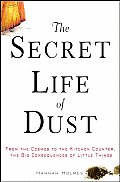Admittedly, this book took on a somewhat daunting task. It tried valiantly to take a very mundane topic and make it interesting. The fact that it failed is tribute not only to the dullness of the topic, but also to the somewhat uninteresting style of the author. The irony of such a statement is not entirely lost on this author but one feels that such a statement cannot be reasonably avoided.
The work seems to be divided into two parts. The first third is an attempt to impress upon the reader the incredible debt that we owe to dust. The Earth, as it repeatedly points out, is comprised of dust thrown up by a hundred suns that burned fiercely and then ended their lives so that our solar system might live. This maudlin and well-established point forms the mainstay of the first 70 pages of the text. The author’s clumsy and ineffectual rendering of this rather romantic and awe-inspiring idea is a clear foreshadowing of what is to come. The latter two-thirds of the book are dedicated to the environmental impacts of particulate matter in the ecosystem. Much of this material is far from novel and well established in previous literature and the authors attempts to render this interesting to the reader can be better described as encyclopedic rather than evocative. All that said, there were a few tidbits of interest that I had not read a dozen times in a dozen previous books.
She very briefly touches on the idea that certain diatoms might have evolved to be more mobile and carried from place to place via the wind. For an ocean-going microorganism, this is a bit of a surprise to me. The concept that microscopic life evolved so that it might more easily colonize disparate environments caused me to ponder for a moment. In a way though, this concept is distasteful as it assumes a sort of “evolution with intent”. I’m not sure I entirely buy the idea that larger, flatter diatoms which can blow from place to place constitute a true evolutionary advantage. The vast majority of the environment is homogeneous so the necessity to invade costal non-oceanic waters seems vastly secondary. That said, the hallmark of evolution is that of invading every possible niche, so perhaps it makes sense.
Since she’s dealing with dust, she also deals somewhat extensively with microbes and among them the microbes which make up an ecosystem entirely of their own in clouds. Admittedly, I considered clouds to be relatively sterile places since they’re primarily composed of water vapor but the author suggests that the upper atmosphere is a rich and diverse ecosystem. It should have come as no great surprise to me that an environment rich in both water and energy should harbor life forms not familiar to us more terrestrial beings, but nevertheless is did. I think we vastly underestimate the cleverness of life on this planet or any other. She also touched with annoying brevity on the life forms present in the sub-surface water reservoirs in the Antarctic. It would be worthwhile to investigate the state of that research more closely.
Much less importantly, the book mentions a couple of random tidbits worth remembering. For example, there are locations in the middle-east and Asia in which homes can be carved from very soft volcanic ash with something as simple as a spoon. The idea of creating a domicile with a simple eating utensil is intriguing to me. Never mind that the homes are highly carcinogenic because of the minerals in the walls. Lastly, the book describes the concept of excarnation which is fascinating to me. Something deep inside me wants to be picked apart by vultures when I die.

No comments:
Post a Comment